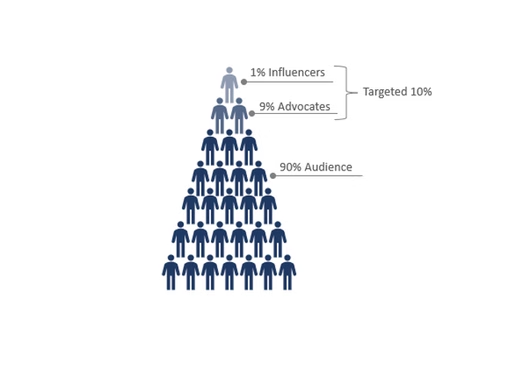What is Audience Architecture?
Communication is key to growing your business. But in order to communicate effectively, you need to understand your target audience – What do they care about? Who do they listen to? How are they consuming content?
Audience Architecture uncovers what drives conversations, interests, and influence among a targeted subset of a brand’s audience. Grounded in the 1-9-90 rule which posits that 10% of users create and share content that is consumed by 90% of the online audience, Audience Architecture identifies the 10% of users whose behavior and interest influence the rest of the market.
The approach begins by diving into the online conversation surrounding a topic to better understand the themes an audience is discussing, who they’re interacting with and following, and what sources they’re sharing most. Once the audience is identified, we can tap into the online conversation in real-time gleaning insights into emerging trends, stories and influential voices. This unique methodology enables us to develop insights that lead to actionable communication recommendations that drive business results.
(For a more detailed discussion of the Audience Architecture approach, visit Ringer Science’s blog post: How Audience Architecture Can Help You Grow Your Brand)
Case Study: Defining Top Executives and Firms for Our Financial Consulting Client
Challenge:
The client came to us with two specific requests – they wanted to better understand their target audience of financial executives (C-suite and beyond) in order to create relevant content that would resonate with these executives as well as develop a methodology for prioritizing and characterizing the executives and companies within their sales pipeline. We developed the following questions to address these challenges:
-
What were the key themes driving financial executives’ content online? What language did they use?
-
Who were financial executives most influenced by online? Where did they source content? What reporters did they engage with and share most frequently?
-
Which companies should their sales team prioritize for outreach? And more importantly, which executives within those companies should they engage with and what is top of mind for these executives?
Approach:
To provide our client with a 360-degree view of the financial industry, we leveraged a multi-pronged approach to break down top-performing content across eight executive positions, then ranked top companies based on client-specific metrics. These unique metrics were tailored to our client’s business objectives and included factors such as corporate diversity, content performance, and social media activity level.
1. Audience Identification
Individuals were identified through a combination of keywords based identification and machine learning. Keywords were developed to identify descriptors of specific roles and companies of interest to our client. These keywords were leveraged by proprietary tools that use machine learning to search for people who are likely to fit the criteria based on their social media bios and online conversations. All identified individuals were then manually validated for accuracy and relevancy.
2. Executive Analysis
To understand language and themes that mattered most to executives, we analyzed over 3,100 posts from 1,300 executives across LinkedIn and Twitter over a four month period. In addition, we identified influencers in the space whose content were often shared and engaged by key audiences. We conducted an additional benchmarking analysis to identify correlations between executive positions and the highest performing content within the financial industry. This enabled us to dig deeper and find the targeted 10% that influence the broader audience, shedding light on what resonates with our audience, who posts what type of content, and why it performs well.
3. Company Analysis
To provide our client with a list of priority companies for sales outreach, we analyzed executives’ content across 445+ companies. Using proprietary scoring algorithms, we ranked the top 100 companies within the financial services sector based on
-
Engagement with client-specific thematic pillars including corporate diversity
-
Social media content performance
-
Social media activity levels
This provided our client with a clear list of companies and executives they should reach out to based on criteria specific to their goals. Secondly, we conducted corporate conversation analyses for top-tier companies to better understand what’s top of mind for executives. These insights provided our client with a 360-degree view of the priorities for the company and the executive to fuel discussion during initial outreach.
Results:
Our analysis proved that across executive positions, content on Diversity, Equity and Inclusion (DE&I) topics drove online engagement. However, when CEOs and Chief Diversity Officers (CDOs) shared company corporate social responsibility (CSR) content, their posts over-indexed against the average engagement rate. In addition, we identified top companies for partnership opportunities based on top-performing executives paired with key metrics specific to our client.
-
Four of Our Client’s Favorite Key Findings:
#1 – More diverse C-suite executives tend to have more engaged audiences – While top-scoring companies with a more diverse C-suite tended to have less socially active executives and posted at lower frequencies than average financial companies, their LinkedIn content had 3 times higher engagement rates compared to less diverse companies who were more active on social.
#2 – Across financial executive’s content, posts related to corporate social responsibility (CSR) generate the highest rates of engagement – While only 13% of CEOs posted content related to company CSR, these posts resonated with audiences and were directly correlated with the top-ranked companies according to internal scoring metrics.
#3 – When Chief Diversity Officers (CDOs) stray from the norm and share company CSR content, their posts do exceptionally well – While DE&I was the most popular content shared among CDOs, company CSR performed best across CDOs with posts performing 90% above average engagement.
#4 – Executives are influenced by top-tier news outlets including The Huffington Post, The New York Times, and DE&I media outlets – While 4 out of 5 top-followed journalists were from The New York Times, Arianna Huffington with The Huffington Post was the most followed among executives. In addition, diversity drew executives’ attention with 38 executives following DE&I-focused media accounts with the most popular being Diversity Inc.

So What?
Our insights led us to recommend specific company targets as new business prospects that were among top firms publishing and engaging with content relevant to our client’s goals. Following our recommendations, our client confirmed that partnerships with our top-ranked companies were proven to be successful and provided them with a clear path for who to engage with next.
Accompanying our list of top-ranked companies, we provided our client with recommendations for messaging that was likely to resonate with their audience. Using these key messages, our client was able to create owned content (blog posts and social media content) that directly addressed key issues related to CSR and DE&I expressed by their target audience.
Lastly, the most influential journalists identified by our analysis helped prioritize earned media outreach. These media opportunities marked the gold standard of earned media success as we knew these would directly influence their target audience.



